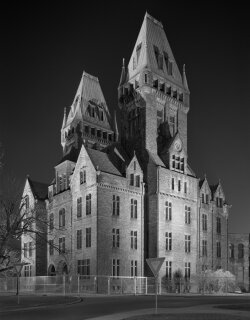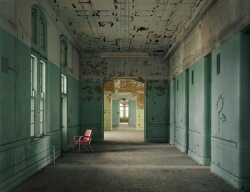Structural psychology: Payne investigates delusions of grandeur
The Villages at Staunton— such an inviting name for the hillside of grand brick buildings rising on the left as Rte. 250 approaches downtown Staunton. Now an upscale enclave of condominiums, the site had a different name when I was little: Western State Hospital, a.k.a. the insane asylum, the crazy house, the loony bin (and where I was headed, according to my brother).
I remember being fascinated by the iron mesh enclosing the windows of the majestic buildings, and I always wondered what lay inside. Apparently, photographer Christopher Payne shared a similar curiosity, and his interest led him to visit 70 institutions in 30 states over six years, documenting the remains of a once-grand American plan to care for the mentally ill. Sixteen of Payne’s riveting images hang in the University of Virginia School of Architecture’s Elmaleh Gallery in the exhibition, “Asylum.”
Expressing the synergy that occurs when a technically skilled artist finds a rich visual vein to mine, Payne’s oversized color images offer archaeological investigations of remnants of patients’ daily lives, decaying interior landscapes, and the soaring facades of now-empty institutions. The subject matter is compelling, but Payne’s eye for color and detail combined with his compositional skill moves the images beyond documentary into the realm of art.
For instance, in “State Records and Files, Spring Grove State Hospital, Catonsville, Maryland,” the viewer looks across a jumble of cardboard boxes in the foreground, through a central white-framed door— surrounded by peeling institutional-green paint so cracked it resembles a mosaic— toward a white porcelain sink in another room. The content is surreal and unsettling, but what fuels this image’s visual power is that the tan wall beneath the peeling paint behind the sink is the same color as the boxes, and the sink’s rectangular front echoes the white labels on several cartons.
In other images, Payne shows a sense of gallows humor in small details, such as a grimy tube of toothpaste lying on a dusty shelf below rows of toothbrushes, or a drip tray left beneath a rack labeled “skeleton” in an autopsy theater. Payne ironically punctuates the looming gothic edifice in “Buffalo State Hospital, Buffalo, New York,” by including two “yield” signs on the street below.
With many of these once-magnificent asylums now demolished or “repurposed,” Payne’s disturbingly beautiful photographs bear witness to a lost era with an altered mindset.
Christopher Payne’s exhibit, “Asylum,” is on view through April 14 in the Victor and Sono Elmaleh Gallery in the University of Virginia School of Architecture. Campbell Hall. 982-2921.


